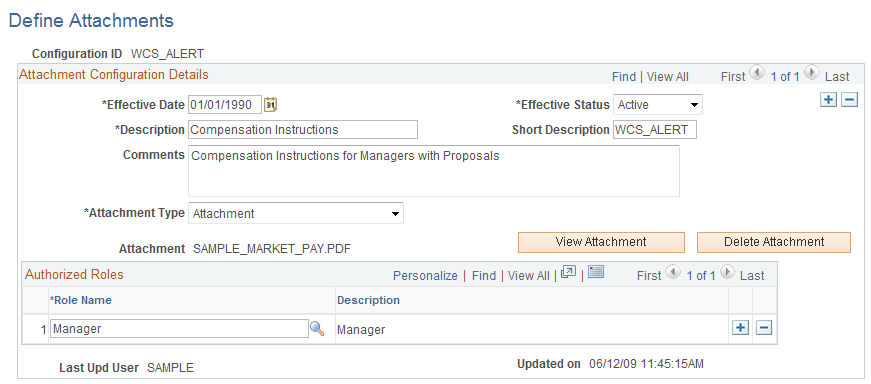Document and Link Configuration
The HCM Attachment Framework is a flexible and user-friendly component for integrating document and link management for specific application areas. Using the pages included in the Attachments component, you can make documents or links context-sensitive and provide security based on standard PeopleSoft roles, permissions, and data values in HCM.
Here is how the system displays the Attachments group box to users in Manager Self Service:
This example illustrates the fields and controls of the Attachments group box displayed in pages.

Because the implementation of the Attachment Framework depends on a predefined set of keys, PeopleSoft has delivered system data that specifies the key structure for Compensation Alert documents. On the Configure Keys page the HWCS object owner ID and ALRT sub ID define the application that has been implemented for use.
Note: eCompensation Desktop Manager has not implemented the ability for users to add or update existing documents. All documents must be defined and loaded by the compensation administrator using the Attachment pages. Therefore, stored attachment documents are displayed as read-only to the user.
Located in the Attachments folder, the Define Attachments page (select allows you to specify a configuration for each document or link. To simplify this concept, think of a configuration as the system's identifier for a defined document target. The term attachment includes both documents and links. The term configuration refers to many types of files, including Word documents, Excel spreadsheets, PDF files, or links to internal or external websites. The configuration provides the details regarding the intended target including a complete definition, a status, and the type or form of attachment. More importantly, it stores the actual document or link and the PeopleSoft roles that are allowed access to it.
On the Define Attachments page, PeopleSoft recommends that you use the same ID to set up both the attachment configuration and the compensation cycle ID. Although this is not required, it is beneficial to use the compensation cycle ID as the key identifier for the attachment. For example, if you have an annual merit cycle called 2012 Focal, a configuration ID of 2012 FOCAL allows you to quickly identify the attachment that is associated to that particular compensation cycle. This can be helpful if you are administering many compensation cycles that need their own attachments. In addition, the effective date enables you to create multiple versions of the same document over time for the same configuration.
To attach a document or URL to an alert, select On the Define Attachments page select WCS_ALERT as the configuration ID. You can then change the instructional text, or add an attachment and URL. In addition you can select the roles to which the system will display the alert and attachment or URL.
Here is an example of the Define Attachments page for compensation instructions using the WCS_ALERT configuration ID:
This example illustrates the fields and controls on the Define Attachments page.

The Maintain Definitions page enables you to set up context-sensitivity for each attachment configuration. It is the combination of two key values – Compensation Cycle ID and Event Code – that enable you to define the scope of the document's availability to the end user. You can set up the context keys in any combination, including a blank value that means any. The key values prompt against the Compensation Cycle Configuration and Compensation Alert Setup tables for selection. The system performs no specific validation as the combination of the two keys (including the effective date) will typically result in a found attachment.
Note: At a minimum, the event code should be specified; otherwise all alerts (regardless of event code) could potentially retrieve the same attachment configuration. The system attempts to locate and retrieve the configuration for an attachment when a user attempts to access the Allocate Compensation page (select ). If the system finds a valid attachment, it displays the Info column and a link in the form of an icon. Conversely, if the system does not locate a attachment for any of the alert messages listed in the grid, it hides the column. When the user clicks the Info icon, the system opens a new browser window and displays the associated document.